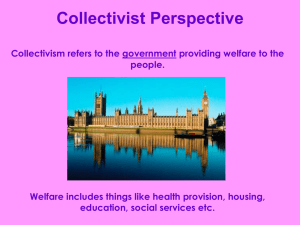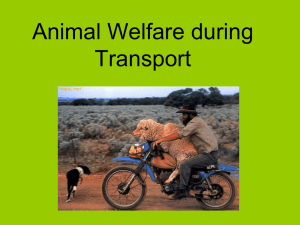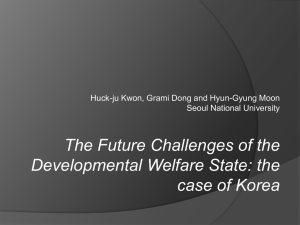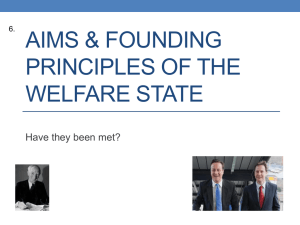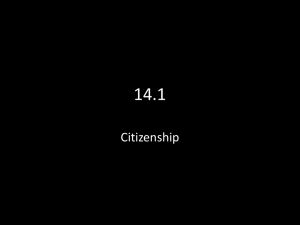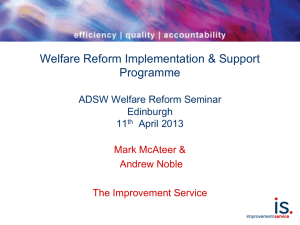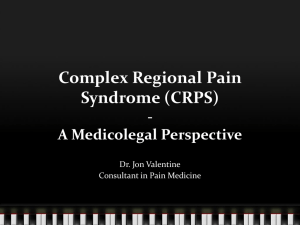Child Welfare Agencies and Citizen Review Panel Collaboration
advertisement
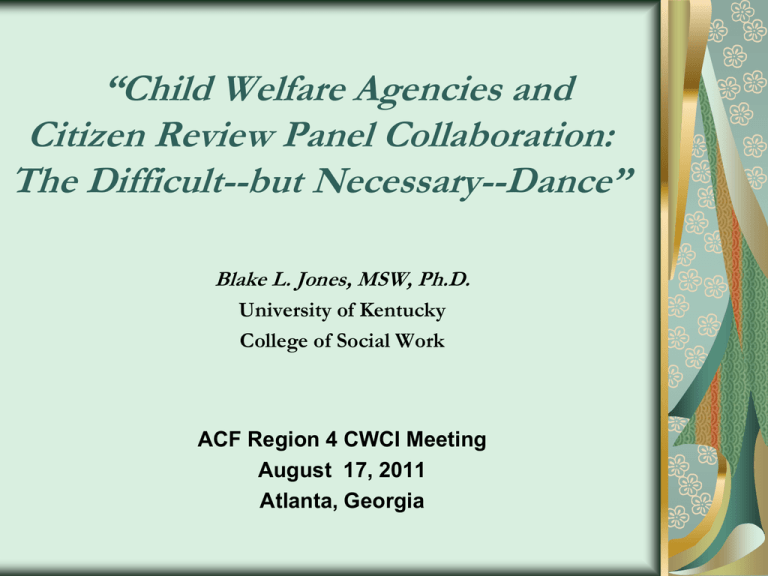
“Child Welfare Agencies and Citizen Review Panel Collaboration: The Difficult--but Necessary--Dance” Blake L. Jones, MSW, Ph.D. University of Kentucky College of Social Work ACF Region 4 CWCI Meeting August 17, 2011 Atlanta, Georgia WHAT IS YOUR VISION FOR YOUR STATE’S CITIZEN REVIEW PANELS? Arnstein’s “Ladder of Participation” Citizen Participation in Other Fields Public Administration (Box, 1998; Denhardt & Denhardt, 2000; King, Feltey, & Susel, 1998, Thomas, 1995) > Shift from “informing” citizens of government projects to “involving” them (i.e., maximum feasible participation) > Mixed results (Big question for administrators to answer: WHY are citizens being used?) Environmental Issues (Peelle, et al., 1996) “successful” citizen participation requires…. Agency clarity on goals and stakeholder roles in public participation Top management commitment to the public participation process Manager/leader goes beyond legal minimum Agency responsiveness to stakeholders Two-way communication and education Adequate resources Development of provisional trust between agency and public Giving priority to trust building actions Openness of the agency Why is Citizen Participation in Public Child Welfare Important? It prevents the child welfare agency from becoming a “system unto itself” It moves us toward “community based” protection of children (the BEST way!) Citizen can be advocates for the agency It educates citizens about what is really happening with child abuse and neglect It’s democracy in action…. An Auspicious Beginning? “By allowing the Panels to have complete access to child protection cases, by requiring Panels to publicize their findings, and by requiring states to respond to criticisms and recommendations of the Panels, the Committee intends to subject states to public criticism and political repercussion if they fail to protect children” ~House report 104-081, p. 1 History of CRPs Citizen Review Panels were formed through a 1996 amendment to the Child Abuse and Prevention Treatment Act (CAPTA) 3 panels per state by July, 1999 (some only needed one) Each panel has the responsibility to review compliance of state and local CPS agencies with respect to: state CAPTA plan (basically ANY child protective services) Other criteria the panel considers important, which may include coordination with foster care and adoption programs and review of child fatalities and near fatalities Requirements for Citizen Review Panels Composed of volunteer members that are broadly representative of the community in which they are operating include individuals with expertise in the prevention and treatment of child abuse and neglect Meet at least quarterly Examine policies and procedures and, where appropriate, specific cases of both state and local agencies Maintain confidentiality Prepare an annual report with activities and recommendations Requirements from 2003 CAPTA Reauthorization Evaluate PRACTICES as well as policy and procedure Develop a means for public comment Child welfare agency is to respond in writing to annual report within six months NEW from CAPTA 2010 ReAuthorization CRPs “may include adult former victims of child abuse or neglect” Directs Secretary of HHS to conduct a study on the effectiveness of CRPs by 2012 Common Themes CRP coordinated by someone from state child welfare agency Struggle with “diverse” membership and involving “nonprofessionals” Trouble in defining the “mission” and outcomes of CRP (“watchdog” vs. “advocate”) Retention of members is difficult Turnover in state agency (i.e., new administrations) Difficulty in connecting with Child and Family Services Review A Selection of CRP Successes Nationally Minnesota CRPs have done research projects around the issue of father involvement in case planning Maine hosted a large statewide child welfare conference in 2010, involving over 300 participants South Carolina made the commitment to work with their child welfare agency and hosted the 2011 national conference Wyoming has formed a CRP on the Wind River Indian Reservation Examples of Recommendations Made Nationally Child welfare agency should implement an online mandated reporter training (GA) Develop a brochure to be given to families who are chosen as “kinship care” (SC) The Child Welfare Agency and the Department of Education should develop a joint training on child abuse to be given to teachers and other school personnel (NJ) CPS caseworkers should receive additional training on identifying child and family needs related to mental health disorders, developmental disabilities, and substance abuse disorders (NV) Use a “risk simulator” similar to the ones used by police to train social workers (KY) Challenges to Collaboration Citizens have trouble understanding complexities of state agencies (“Feel like we’re treading water”) Difficulty in choosing evaluative topics of any substance and value CRPs get lost in the sea of “citizen groups” who are charged with evaluating CPS More obstacles… Distrust from frontline workers Overwhelming nature of NCANS, PIP, CFSR, etc. Time lag between when new initiatives are launched and CRPs are informed (“we had to read it in the paper…”) Some members see Panels as a way to “stick it to” the child protection system Research tells us that Citizen Review Panels generally do better when they are… Given access to information Consulted EARLY in the policy development process Given FEEDBACK about their recommendations Provided staff and other logistical support Are part of a thoughtful, well-defined process rather than a “feel good” exercise What Makes a “Bad” CRP? Unclear or conflicting goals Poor leadership from chairperson No follow through on commitments “axe grinders” Lack of communication from child welfare agency “Policy overload” Membership turnover (always “starting from scratch”) The Elements of Successful Citizen Review Panels A clear focus and strategic plan A trusting relationship with the child welfare system Ability to view the “big picture” of incremental change within large bureaucracies Staff and other logistical support Ability to engage in ongoing dialogue (this is more than “trading reports”) Ability to connect with other child advocates in the state Meetings which are productive and move the group toward a common goal What have we learned? Clearly define roles of responsibilities of CRPs and child welfare agency (this should be spelled out in a Memo Of Agreement) Give feedback to Panels about what happens to their recommendations. If they are not feasible, say so, and explain why Create consistent “point persons” within the agency to answer critical questions. Have a way for members to cycle on and off the Panel What have we learned? Work on team development (use cohesion scale to assess) Work with Chairperson to develop her or his leadership abilities Provide at least a part-time paid staff person (be CREATIVE, sub-contract with a University to coordinate CRPs) Celebrate successes and improvements Value citizenship An Example of a Successful CRP Topic TOPIC: How frontline Kentucky child welfare workers are trained to respond to “meth” cases KY CRP reviewed policy, talked with frontline workers and supervisors, law enforcement, first responders RESULT: Changes in policy which made workers and children safer Selected References Bryan, V., Collins-Camargo, C., & Jones, B. (2011). Reflections on citizen-state child welfare partnerships: Listening to citizen review panel volunteers and agency liaisons. Children and Youth Services Review, 32, 1, 986-1010. Jones, B.L. & Royse, D. (2008) Citizen review panels for child protective services: A national profile. Child Welfare, (87), 3, 143-162. Bryan, V., Jones, B.L. & Lawson. (2010). Key features of effective citizen–state child welfare partnerships: Findings from a national study of citizen review panels. Children and Youth Services Review, 32, 4, 595-603. Jones, B. L. (2004) Variables Impacting the Effectiveness of Citizens Review Panels For Child Protective Services: A Multi-state Study. Children and Youth Services Review, (26) 12, 1117-1127. Collins-Camargo, C., Jones, B.L, & Krusich, S. (2009). The “Spinach” of Citizen Participation in Public Child Welfare: Strategies for Involving Citizens in Public Child Welfare. Journal of Public Child Welfare, 3, 287-304. Jones, B.L., Litzelfelner, P. & Ford, J.P. (2003) Making a Change or Making a Report: Change Perceptions of Citizens Review Panel Members and Child Protective Workers. Child Abuse & Neglect: The International Journal., (27) 699-704. Jones, B.L. & Royse, D. (2008) Citizen review panels: The connection between training and perceived effectiveness. Child Abuse & Neglect: The International Journal) 32, 1-2. Bryan, V., Jones, B.L., Allen, E. & Collins-Camargo, C. (2007) Child and Youth Services Review Civic Engagement or Token Participation? Perceived Impact of the Citizen Review Panel Initiative in Kentucky. 29, 1286– 1300 Litzelfelner, P., Collins-Camargo, C. & Jones, B. L. (2003) Models for Involving Citizens in the Child Welfare System in Kentucky: An Overview. Kentucky Children’s Rights Journal., Spring, 2003. Practical Advice Do….. Don’t…. Focus on building a trusting, honest relationship with your child welfare agency Choose a work project that is large and unmanageable Become an integral part of the Program Improvement Plan!!!! Spend your time in meetings “chasing rabbits” Do a “project” during the year (i.e., host a conference, do a community service project, do something for frontline workers) Develop a mechanism whereby you follow your recommendations over the years Get a practicum student Try to find a project that aligns with the PIP! Neglect the health of your group Be afraid to ask for what you need, but…. Don’t get overly defensive if the answer is “no” SMART Indicators for CRP Topics Specific Measurable Achievable Realistic Time Limited The national scene… University of Kentucky is the organizing “hub” for Citizen Review Panels National Citizen Review Panel Virtual Community (www.uky.edu/socialwork/crp) * Annual Reports * Training Materials * Sign up for Listserv * Information from Annual Reports * Articles, Tip Sheets National CRP Conference will be held in Washington, DC on April 15-17, 2012

